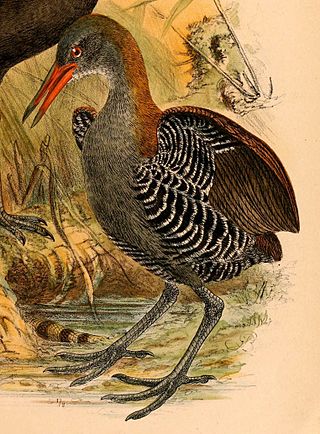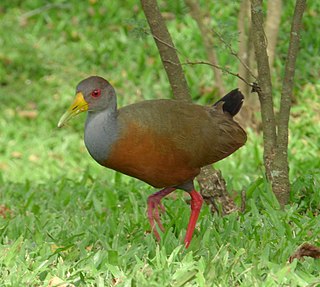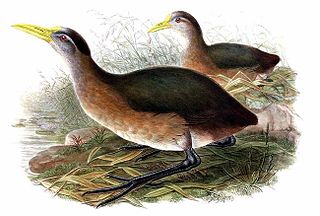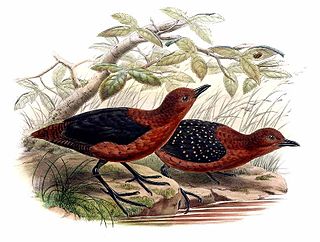
Rails are a large, cosmopolitan family of small- to medium-sized terrestrial and/or semi-amphibious birds. The family exhibits considerable diversity in its forms, and includes such ubiquitous species as the crakes, coots, and gallinule; other rail species are extremely rare or endangered. Many are associated with wetland habitats, some being semi-aquatic like waterfowl, but many more are wading birds or shorebirds. The ideal rail habitats are marsh areas, including rice paddies, and flooded fields or open forest. They are especially fond of dense vegetation for nesting. The rail family is found in every terrestrial habitat with the exception of dry desert, polar or freezing regions, and alpine areas. Members of Rallidae occur on every continent except Antarctica. Numerous unique island species are known.
The Calayan rail is a flightless bird of the rail, moorhen, and coot family (Rallidae) that inhabits Calayan Island in the Philippines. It is the only member of the genus Aptenorallus. Though well known to natives of the island as the "piding", it was first observed by ornithologist Carmela Española in May 2004 and the discovery was officially announced on August 16, 2004. The formal description as a species new to science appeared in the journal Forktail.

The black rail is a mouse-sized member of the rail family Rallidae that occurs in both North and South America.

The Guam rail is a species of flightless bird in the Rallidae family, endemic to the United States territory of Guam. It is known locally as the Ko'ko' bird. It was extirpated from the entire island by the late 1980s owing to the predation of the Brown tree snake, an invasive species not native to the island.

The Rodrigues rail, also known as Leguat's gelinote or Leguat's rail, is an extinct species of the rail family that was endemic to the Mascarene island of Rodrigues. The bird was first documented from life by two accounts from 1691–93 and 1725–26. Subfossil remains were later discovered and correlated with the old accounts in 1874, and the species was named E. leguati in Leguat's honour. It is generally kept in its own genus, Erythromachus, but has sometimes been assigned to the genus Aphanapteryx along with its close relative the red rail of Mauritius; their relationship with other rails is unclear.

The invisible rail, Wallace's rail, or drummer rail is a large flightless rail that is endemic to the island of Halmahera in Northern Maluku, Indonesia, where it inhabits impenetrable sago swamps adjacent to forests. Its plumage is predominantly dark slate-grey, and the bare skin around its eyes, the long, thick bill, and the legs are all bright red. Its call is a low drumming sound which is accompanied by wing-beating. The difficulty of seeing this shy bird in its dense habitat means that information on its behaviour is limited.

The snoring rail, also known as the Celebes rail or Platen's rail, is a large flightless rail and the only member of the genus Aramidopsis. The species is endemic to Indonesia, and it is found exclusively in dense vegetation in wet areas of Sulawesi and nearby Buton. The rail has grey underparts, a white chin, brown wings and a rufous patch on the hind-neck. The sexes are similar, but the female has a brighter neck patch and a differently coloured bill and iris. The typical call is the snoring: ee-orrrr sound that gives the bird its English name.

The grey-cowled wood rail or grey-necked wood rail is a species of bird in the family Rallidae, the rails. It lives primarily in the forests, mangroves, and swamps of Central and South America. Of the two subspecies, A. c. avicenniae is found in southeastern Brazil, while the nominate is found throughout the portion of the range not occupied by the other subspecies. The species as a whole is usually found at elevations from sea level to 2,000 metres (6,600 ft), although some have been found above that. This bird's large extent of occurrence along with its population is why it is considered to be least-concern by the International Union for Conservation of Nature (IUCN). In some places, it is occasionally hunted and kept for food.

The brown wood rail is a Vulnerable species of bird in the subfamily Rallinae of the rail, crake, and coot family Rallidae. It is found in Colombia and Ecuador.

The Madagascar forest rail, also known as the Madagascar wood rail or the kioloides rail, is a species of bird in the family Sarothruridae. It is endemic to forests, often in wet areas, in northern and eastern Madagascar. The Madagascar forest rail is a secretive and shy species, often showing elusive behavior, such as running away from the slightest disturbances. This has contributed to a lack of study on this species; a reason why it is not that well known.

The Okinawa rail is a species of bird in the rail family, Rallidae. It is endemic to Okinawa Island in Japan where it is known as the Yanbaru kuina. Its existence was only confirmed in 1978 and it was formally described in 1981 although unidentified rails had been recorded on the island since at least 1973 and local stories of a bird known as the agachi kumira may refer to this species.

The New Guinea flightless rail, also known as the Papuan flightless rail, is a species of bird in the family Rallidae, in the monotypic genus Megacrex. Sometimes however, it was included in Amaurornis or Habroptila, but this is incorrect.

Rallina is a genus of bird in the rail family, Rallidae. It contains four species found in forest and marshland in Asia and Australasia. They are 18–34 cm long and mainly chestnut or brown, often with black and white markings. They are four species that are now placed in the genus Rallicula that were previously included in the genus Rallina. In fact, some taxonomic authorities continue to place them there. A fifth species, the Great Nicobar crake was proposed but not accepted as a separate species.

Forbes's forest rail or Forbes's forest crake, is a species of bird in the family Sarothruridae. It is found in New Guinea. Its natural habitats are subtropical or tropical moist lowland forest and subtropical or tropical moist montane forest.
The white-striped forest rail is a species of bird in the family Sarothruridae. It is endemic to West Papua, Indonesia. Its natural habitat is subtropical or tropical moist montane forests. It is threatened by habitat loss.
Mayr's forest rail is a species of bird in the family Sarothruridae. It is found in northern New Guinea.

The chestnut forest rail, also known as the chestnut forest crake, is a species of bird in the family Sarothruridae. It is found in the Arfak Mountains and western-central New Guinea Highlands. Its natural habitat is subtropical or tropical moist montane forests.

Sarothruridae is a family of small- to medium-sized ground-living birds found mostly in Madagascar and sub-Saharan Africa, with the genus Rallicula being restricted to New Guinea and the Moluccas. The species in this family were once considered to sit with the larger rail family Rallidae.

Mentocrex is a genus of birds in the flufftail family, Sarothruridae. The genus includes two species, both of which are endemic to forests in Madagascar.
The Tsingy forest rail, also known as the Tsingy forest rail, is a species of bird in the family Sarothruridae that was scientifically described in 2011.















